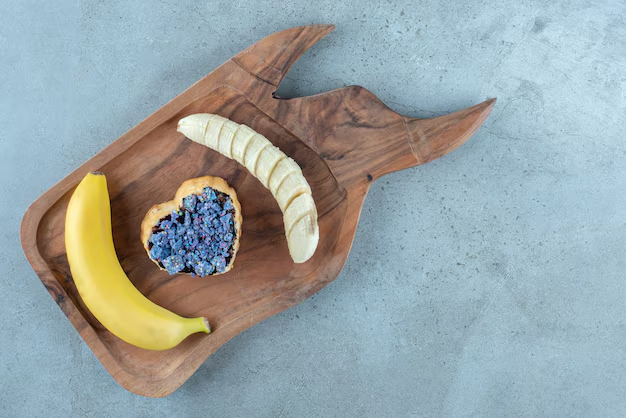Understanding Why Bananas Turn Brown in the Refrigerator
Bananas are a beloved fruit, widely celebrated for their sweet taste and practical packaging. However, they often surprise us by turning an unappetizing brown when stored in the refrigerator. If you've ever opened your fridge to find freshly bought bananas turning brown much sooner than expected, you're not alone. This phenomenon can leave many wondering about the underlying reasons. Let's delve into why bananas, once refrigerated, tend to lose their sunny color and explore related topics for practical fruit storage.
🍌 Why Bananas Turn Brown
The Science Behind the Browning
The browning of bananas is primarily due to a chemical process called enzymatic browning. This process involves enzymes known as polyphenol oxidases (PPOs), which react with oxygen in the air to produce brown pigments called melanins. When you refrigerate bananas, the cold temperatures disrupt the cells of the banana peel, causing more PPO activity. Here's why:
Cell Damage: Cold temperatures damage the cellular structure of the banana peel, catalyzing PPO activity. This increases exposure to oxygen, accelerating browning.
Chilling Injury: Bananas thrive in tropical climates, making them sensitive to cold temperatures. When placed in a fridge, they suffer from chilling injury where the peel cells break down, leading to faster browning.
Do Other Fruits React Similarly?
While bananas are notorious for their quick browning when chilled, other fruits also experience browning, albeit in different ways. Apples and pears are common examples where enzymatic browning occurs, though it often starts with cuts or bruises. However, unlike bananas, their flesh browning can sometimes be slowed by refrigeration.
🥶 Is Refrigeration Always Bad for Bananas?
The Case for Room Temperature
Storing bananas at room temperature helps maintain their color and quality for a longer period. Here's what happens when bananas are kept at room temperature:
- Ripening: Bananas continue to ripen at room temperature, enhancing their sweetness as starches convert to sugar.
- Slowed Browning: Though they may still brown with extended exposure to air, without the cellular breakdown caused by cold, it’s often at a slower rate.
When Refrigeration Works
Surprisingly, refrigerating bananas isn't always detrimental. Once ripe, putting bananas in the fridge can help keep the fruit's flesh intact and extend the edible period, even if the peel continues to brown.
Pro tip: If you'd like to refrigerate bananas without them browning too quickly, cover the stems securely with plastic wrap. This method can slow down the ethylene gas release, which accelerates ripening.
🍽️ Creative Ways to Use Browning Bananas
Fear not if your bananas have browned prematurely in the fridge. They aren't necessarily destined for the trash. Browning bananas are perfect for:
- Baking: Overripe bananas are ideal for baking, providing natural sweetness and moisture in banana bread or muffins.
- Smoothies: The softness and sweetness make them a perfect addition to a smoothie.
- Pancakes or Waffles: Mash them into batters to create delicious breakfast treats.
🍏 Understanding Ethylene and Its Role
What is Ethylene?
Ethylene is a colorless gas, and a natural plant hormone identified as a key player in the ripening process of fruits. Bananas produce ethylene, and its buildup catalyzes the ripening process, which is why one ripe banana in a fruit bowl can hasten the ripening of others nearby.
Ethylene Management Tips
- Separate Bananas: To minimize accelerated ripening, consider keeping bananas apart from other ethylene-sensitive fruits.
- Storage: If only a portion of your bananas is ripe, store them apart to control the ripening rate of those you’d like to preserve longer.
🌱 Eco-friendly Ways to Prevent Waste
Brown bananas, refrigeration concerns aside, shouldn't always mean waste. Here are some environmental and creative considerations:
- Composting: Only if inedible, bananas are rich in nutrients suitable for composting.
- Banana Peels: Use in plant fertilizer mixes. Peels contain minerals beneficial to plants.
- DIY Beauty: Banana peels can be used in natural skincare routines for gentle exfoliation.
Visual Tip Summary 📊
Here's a brief bullet-point guide to maximize banana life and minimize browning:
- 🚫 Avoid Refrigeration if the peel's appearance is a concern.
- 🍃 Keep Ethylene-Producing Fruits Apart to control ripening speed.
- 🌡️ Store at Room Temperature for ongoing ripening and enjoyment.
- 👩🍳 Culinary Uses for Brown Bananas: Baking, smoothies, pancakes.
- 🌿 Eco-friendly Disposal: Compost and creative peel uses.
🍎 Broader Insights: Fruit Storage Tips
General Best Practices for Fruits
Different fruits have various storage needs. While bananas prefer room temperature without direct sunlight, here's a quick overview for others:
- Apples & Pears: Store in fridge crispers but allow to ripen first at room temp if needed.
- Berries: Refrigerate and consume or freeze promptly due to short shelf life.
- Citrus Fruits: Generally stable at cool room temps but can be refrigerated for longer life.
Emphasizing Seasonal Choices
Eating bananas and other fruits when they are in season ensures better quality and shelf life. Seasonal produce is more resilient to storage conditions.
Fostering Healthier Food Habits
Understanding why bananas turn brown in the fridge can also help cultivate more robust food storage habits. Teaching oneself and others about the nuanced needs of various fruits not just preserves flavor but also keeps food waste down.
In conclusion, the key takeaway is that while bananas may brown under cold storage, their usability remains vast. Learning the best ways to store and use them maximizes their potential, offering nutritional delight without waste. So next time you notice bananas browning in the fridge, consider it an opportunity for a delicious kitchen endeavor rather than a sign of spoilage.
